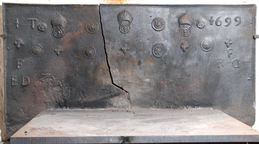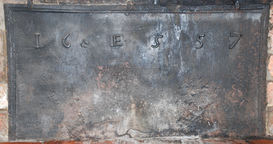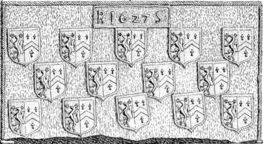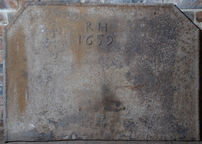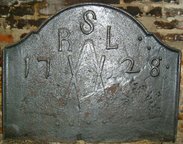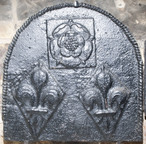-
1035
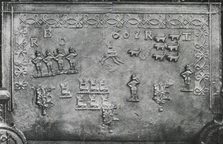 ? x ? mm
? x ? mmDescription: Rectangular with furniture-derived mounding (top and sides); double-loop 'lens' pattern stamp repeated inside the moulded edging nine times along the top and three times down each side; top left, initials RBD in triad; right of top centre, date 1602; top right, initials RT split between two repeated dog stamps; four other dog stamps in pairs below, and one below date; becapped human figure stamp, with his left arm raised to his head and his right arm akimbo, repeated four times below initial triad and two singly, one below lone dog stamp and one centre right; top centre, stamp of a crest formed of a stag 'lodged' (i.e. sitting) upon a wreath, in this instance only with pseudo legs drawn below, also repeated six times in two rows of three left of lower centre, with one to the left of the six; 'renaissance' shield bearing initials 'IE' linked with twisted cord, repeated lower left and right with a third bottom centre impressed partially over the centremost stag crest.
Notes: A fireback remarkable for the haphazard arrangement of groups of seemingly unrelated stamps. Acquired in 1900 by Sir Spencer Maryon-Wilson for Charlton House (Country Life, 23 April 1904, from whence has come the illustration); several of the stamps have been noted on two other firebacks, both dated 1617, and suggesting by their location an origin in the Horsham area of the Weald.
Inscription: R B D [triad] 1602 R T / IE IE / IE
- Decoration tags:
- rectangular (shape)
- furniture moulding (edging)
- carved stamps
- heraldic
- monogram
- text
- animals
- humans
Manufactured: in 1602 in the Weald area of England.
Current location: not known.
Citation: Gardner, J. S., 30 Apr 1904, 'An old fire-back' (letter), Country Life, p. 647.
Citation: S. M. W. [Spencer Maryon-Wilson], 23 Apr 1904, 'An old fireback' [letter], Country Life, p. 611.
Citation: Shuffrey, L. A., 1912, The English Fireplace, London, Batsford.
-
968
Description: Rectangular; truncated egg and dart moulded edging on top and left side; top right of centre, date in individual over-pressed stamps; initials in over-pressed stamps centred below date.
Notes: A rare use of egg and dart moulding used as separate edging, presumably derived from redundant domestic moulding or furniture.
Inscription: 1637 / H V
- Decoration tags:
- rectangular (shape)
- egg and dart (edging)
- individual letters
- individual numbers
- text
Manufactured: in 1637 possibly in the Weald area of England.
Current location: in private hands, Cowden, Kent, England.
- Attached to series:
- Date & initials firebacks
-
969
Description: Cavetto-canted rectangular shape; astragal edging (top and sides); letters in triad between separated date.
Notes: The modest size of this fireback reflects the decreasing size of fireplaces in the 18th century.
Inscription: 17 TRS [triad] 31
- Decoration tags:
- rectangular with canted top corners (shape)
- astragal (edging)
- individual letters
- individual numbers
- text
Manufactured: in 1731 in the Weald area of England.
Current location: in private hands, Cowden, Kent, England.
- Attached to series:
- Date & initials firebacks
-
887
Description: Rectangular; stepped fillet edging (top and sides), ending short of bottom of plate; rose and crown stamp repeated three times across top of plate, with initials 'IT' followed by a rose stamp to left, and a rose stamp followed by the date to right (1 or I crossed in both cases); concentric roundel stamp between each pair of rose and crown stamps; lower down, five small inverted fleurs-de-lys between four concentric roundels; below left, initials FED in triad; below right, FRD in triad (D reversed).
Notes: An alleged connection with the Tichborne family who lived at Crippenden in Cowden, Kent, may be justified if the initials, IT, refer to John Tichborne, the last of his family in the village, who died in 1708. The identities of those whose initials form the two triads is not known. The style of rose and crown is similar to that used in gun founding in the Tudor period, suggesting that the furnace that was the source of this fireback may have been used for that purpose.
Inscription: IT 1699 / EFD [triad] RFD [triad]
- Decoration tags:
- rectangular (shape)
- stepped fillet (edging)
- carved stamps
- individual letters
- individual numbers
- heraldic
- text
- objects
Manufactured: in 1699 in the Weald area of England.
Current location: Crippenden Manor, Cowden, Kent, England.
- Attached to series:
- 1660s-90s Wealden series
- Date & initials firebacks
-
38
Description: Rectangular; fillet and astragal edging; initials between date in one horizontal line, upper half of plate.
Inscription: 16 ES 57
- Decoration tags:
- rectangular (shape)
- astragal & fillet (edging)
- individual letters
- individual numbers
- text
Manufactured: in 1657 possibly in the Weald area of England.
Current location: Cowfold Cottage Tandoori, Cowfold, West Sussex, England.
- Attached to series:
- Date & initials firebacks
-
1007
Description: Rectangular; twisted rope edging on top and sides; cavetto-moulded-edged rectangle top centre, enclosing date between initials; 14 shields of Ayloffe impaling Sulyard arranged 5-4-5; Ayloffe: sable, a lion rampant Or, collared gules, between three crosses formy of the second; Sulyard: argent, a chevron gules between three pheons inverted sable.
Notes: William Ayloffe (c1535-1584) of Bretons, Hornchurch, Essex, Justice of the Court of Queen's Bench, married (c1560) Jane, dau. of Sir Eustace Sulyard, of Runwell, Essex. A large number of variants use the same shields; this example, unusually, has the initials RS instead of the more common CT. Illustration from Cowper (1911). Previously at Loddenden, Staplehurst, and before that at Great Cheveney, Marden, Kent.
Inscription: R 1627 S
Arms: Ayloffe impaling Sulyard (William Ayloffe of Bretons, Hornchurch)
- Decoration tags:
- rectangular (shape)
- rope (edging)
- carved stamps
- individual letters
- individual numbers
- armorial
- text
Manufactured: in 1627 possibly at Hawkhurst Furnace in the Weald area of England.
Current location: not known.
- Attached to series:
- Ayloffe series
- Personal armorial firebacks
-
1039
Description: Canted rectangular shape; twisted rope edging (top and sides) in short lengths; top centre, initials above date.
Notes: The initials are likely to be those of Richard Holden, clothier of Cranbrook, who inherited Branden near Sissinghurst in 1623 and who was living there in 1659.
Inscription: RH / 1659
- Decoration tags:
- rectangular with canted top corners (shape)
- rope (edging)
- simple stamps
- carved stamps
- individual letters
- individual numbers
- text
- objects
Manufactured: in 1659 probably at Biddenden Furnace in the Weald area of England.
Current location: in private hands, Cranbrook, Kent, England.
- Attached to series:
- Date & initials firebacks
-
39
Description: Quasi-arched rectangular shaped with cavetto canted top corners; fillet edging; two V-shaped arrangements of laths, one inverted and superimposed over the other, in centre of plate; date split on either side; initials in triangular arrangement above laths.
Notes: The shape of the fireback is very similar to firebacks at Knole, Sevenoaks, of similar date, and may be the product of the same furnace; the 'X' shapes may have apotropaic significance.
Inscription: 17 RSL 28
- Decoration tags:
- rectangular with canted top corners and round arch (shape)
- fillet (edging)
- simple stamps
- individual letters
- individual numbers
- apotropaic
- text
- objects
Manufactured: in 1728 in the Weald area of England.
Current location: Cranbrook Museum, Cranbrook, Kent, England.
- Attached to series:
- Date & initials firebacks
-
1110
Description: Fragment; canted rectangular shape; twisted rope edging (top and sides); top right (i.e. probably top centre), unidentified (apparently inverted) ornamental capital letter 'T'; top left, a triple-loop fleur stamp; between, rose and crown.
Notes: Probably slightly more than half of the original fireback, with stamps also seen on another, commonly copied, fireback. It might reasonably be supposed that the missing half may have also included an ornamental letter, companion to the surviving example. Formerly at Bentley, Halland, Sussex.
- Decoration tags:
- rectangular with canted top corners (shape)
- rope (edging)
- simple stamps
- carved stamps
- heraldic
Manufactured: in the late-16th century in the Weald area of England.
Current location: in private hands, Crowborough, East Sussex, England.
Citation: Fitt, H. F., 1931, 'Queries: Sussex Iron, II', Sussex Notes and Queries, 3, 8, p. 255.
- Attached to series:
- Looped fleur series
-
1111
Description: Arched shape; twisted rope edging (top and sides); top centre, over-pressed Tudor rose stamp on a square block; large diamond-shaped stamp with fleur-de-lys repeated each side below rose, both over-pressed.
Notes: The diamond-shaped stamp has been seen on other firebacks; one of the stamps appears to have been repositioned twice before casting.
- Decoration tags:
- rounded arched (shape)
- rope (edging)
- simple stamps
- carved stamps
- heraldic
Manufactured: in the mid- to late-16th century in the Weald area of England.
Current location: in private hands, Crowborough, East Sussex, England.
- Attached to series:
- Large diamond fleur series


